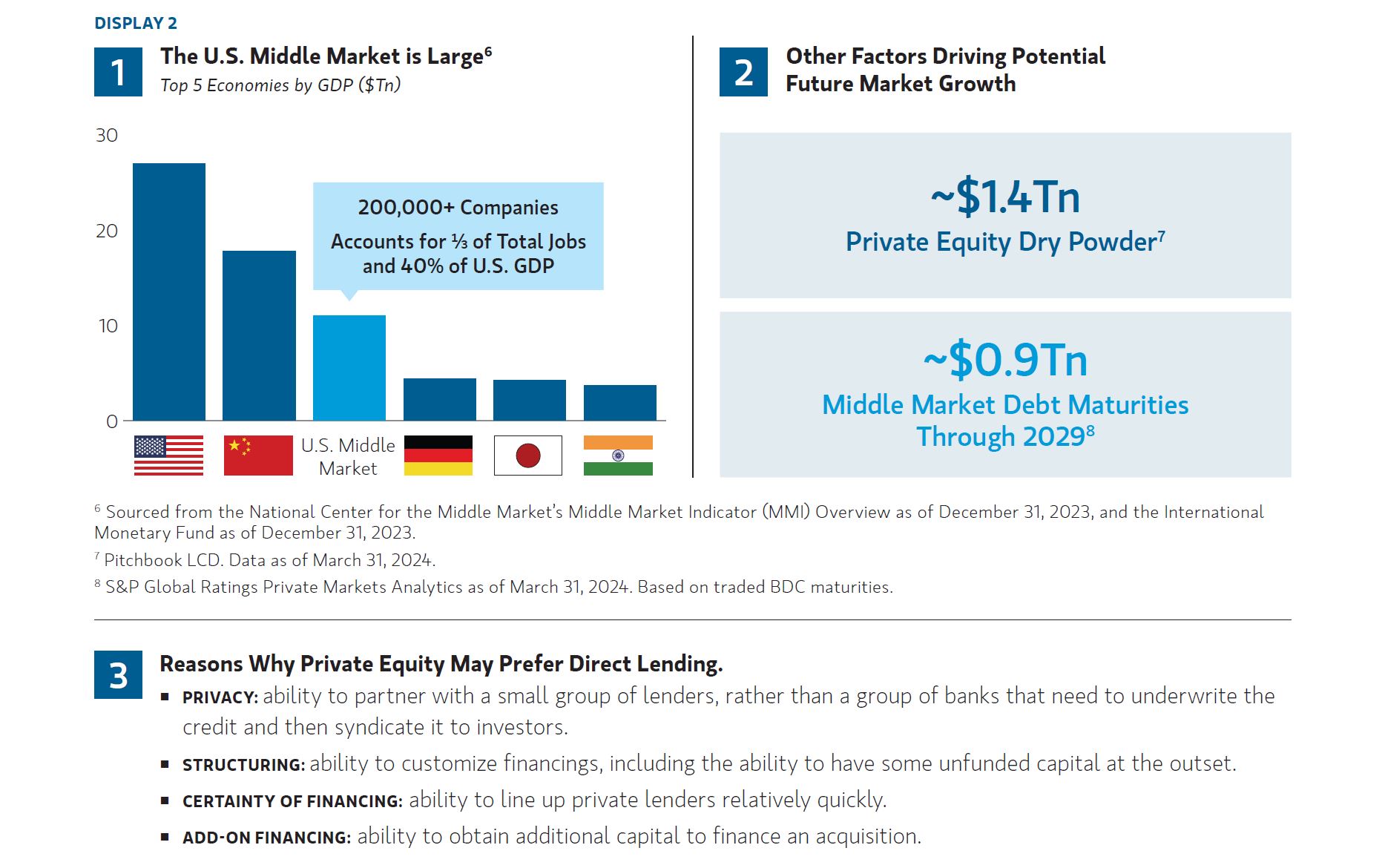KEY TAKEAWAYS
In our opinion:
- The scale of private credit—lending to companies by institutions other than banks—is not outsized when considered in the context of several factors.
- While spreads have tightened, the credit attributes of new deal activity have not changed dramatically in the past year.
- We expect deal flow will continue to increase amid generally conducive private and public financing markets, and as private equity (PE) remains poised to return investor capital.
- Direct lending—private credit extended primarily to middle market companies—remains an attractive market that has historically generated strong risk-adjusted returns.
The Growth of Private Credit—and Direct Lending—in Context
As banks have gradually retreated from middle-market lending, and public capital markets have skewed larger and exhibited volatility, private credit has stepped in to fill the void. Private credit expanded to approximately $1.5 trillion at the start of 2024, up from $1 trillion in 2020, and is estimated to reach $2.8 trillion by 2028.1
This growth has been supported by PE, which controls nearly $8 trillion in assets globally, including $4.1 trillion in the U.S.2 We believe these firms have significant dry powder to invest. All of this is relative to $20T in U.S. bank balance sheets, which have grown by around $7T in the last decade.3
We believe the direct lending market has always been competitive, and the current market is no different. The asset class has generated strong and stable returns for decades and, we believe, will continue to attract investor capital.
We believe that direct lending is positioned for continued growth for three fundamental reasons: (1) the U.S. middle market is large; (2) private equity dry powder remains at record high levels and refinancing volumes are expected to remain high; and (3) there are enduring structural benefits for borrowers.
Cutting through the Noise
Despite recent press on purported lack of transparency and opaque valuation policies in the direct lending space, we believe a host of regulatory, legal, accounting and other regimes dictate that managers abide by stringent valuation policies. These policies are typically multi-layered, and they leverage both internal valuation models and third-party valuation firms to value individual loans. These valuations typically take into account fundamental company performance and market factors. Their frequency will depend on the structure of the fund in which the loans are held. For instance, some perpetually offered business development companies (“BDCs”) could be valued as frequently as monthly.
It is important to remember that in the business of making first lien loans backed by a deep base of sponsor equity, the goal is return of principal.
What We’ve Been Seeing in the Direct Lending Market
- DOCUMENTATION: While competition for deals remains fierce, we generally have witnessed documentation that remains prudent, with proper protections. Intensive credit underwriting and documentation have typically been a trademark of buy-and-hold investing in the direct lending market.
- SPREADS: Spreads on new loans have compressed over the last two years, largely in response to improving risk sentiment and a resurgence in the public capital markets; however, base rates remain elevated, generally resulting in total coupons of ~10%+.
- CREDIT QUALITY: Credit quality has not changed dramatically in the past year. We believe that the sector has performed extremely well throughout this inflationary environment, perhaps in large part due to the resilience of the underlying U.S. economy and the emerging signs that the Federal Reserve’s efforts to combat inflation has begun to work.
- DEFAULTS: Non-accruals and defaults for direct lending remain below historical averages—in the low-single digits. Should interest rates remain elevated, it is possible we would see expectations for defaults to increase gradually and trend to the historical averages. Conversely, repricing activity and lower rates would provide some relief to borrowers.
- DEAL FLOW: Sponsored middle market loan activity remained relatively resilient during the first half of 2024, partly supported by demand for incremental or add-on financings. We remain optimistic that new middle market leveraged buyout activity may accelerate with more visibility on the trajectory for interest rates. We expect deal flow to continue to accelerate into 2025, as PE remains poised to return investor capital.
Conclusion
We believe direct lending continues to offer compelling relative value compared with other assets classes and offers an attractive diversification alternative to public fixed income. And, importantly, when considered in the context of other markets, private credit has significant room to grow.7
1 Preqin, Future of Alternatives 2028 Report. As of December 2023.
2 Preqin, data as of December 2023.
3 Bank of International Settlements data, as of 2023 year end, and 2013 year end.
4 Sourced from the National Center for the Middle Market’s Middle Market Indicator (MMI) Overview as of December 31, 2023, and the International Monetary Fund as of December 31, 2023.
5 Private Equity Buyout Dry Powder is a global figure and sourced from Preqin.
6 Figure is as of December 30, 2023 (most recent available). Sourced from LSEG LPC’s 2Q24 US Syndicated Middle Market Review, includes maturities for the second half of 2024, through to 2029.
7 Preqin, Future of Alternatives 2028 Report. As of December 2023.
RISK CONSIDERATIONS
Alternative investments are speculative and include a high degree of risk. Investors could lose all or a substantial amount of their investment. Alternative investments are suitable only for long-term investors willing to forego liquidity and put capital at risk for an indefinite period of time. Alternative investments are typically highly illiquid—there is no secondary market for private funds, and there may be restrictions on redemptions or assigning or otherwise transferring investments into private funds. Alternative investment funds often engage in leverage and other speculative practices that may increase volatility and risk of loss. Alternative investments typically have higher fees and expenses than other investment vehicles, and such fees and expenses will lower returns achieved by investors.
In the ordinary course of its business, Morgan Stanley engages in a broad spectrum of activities including, among others, financial advisory services, investment banking, asset management activities and sponsoring and managing private investment funds. In engaging in these activities, the interest of Morgan Stanley may conflict with the interests of clients.
Alternative investment funds are often unregulated, are not subject to the same regulatory requirements as mutual funds, and are not required to provide periodic pricing or valuation information to investors. The investment strategies described in the preceding pages may not be suitable for your specific circumstances; accordingly, you should consult your own tax, legal or other advisors, at both the outset of any transaction and on an ongoing basis, to determine such suitability.
No investment should be made without proper consideration of the risks and advice from your tax, accounting, legal or other advisors as you deem appropriate.
Morgan Stanley is a full-service securities firm engaged in a wide range of financial services including, for example, securities trading and brokerage activities, investment banking, research and analysis, financing and financial advisory services. Morgan Stanley Investment Management is the asset management division of Morgan Stanley.
Featured Insights
IMPORTANT NOTICE
The information provided herein (the “Presentation”) is for informational and educational purposes only and should not be construed as advice to make any investment. The Presentation is subject to change, and will not be updated or otherwise revised to reflect information that subsequently becomes available or circumstances existing or changes occurring after the date hereof and should not be relied upon.
This Presentation does not constitute an offer to sell or a solicitation of an offer to buy any securities, including limited liability company, limited partner (or other equivalent) interests in any fund, common equity in a business development company, account or other product sponsored or advised by Morgan Stanley (“MS”, or the “Firm”) nor is a recommendation or commitment on the part of Morgan Stanley.
Historical market conditions and information is not indicative of future results, and the information in this Presentation should not be viewed as an indicator of any future results or market conditions that may be achieved as a result of implementing an investment strategy substantially identical or similar to that described in this Presentation.
Unless otherwise indicated, the views and opinions expressed in the Presentation are those of Morgan Stanley Private Credit (“MSPC”, “we”, “our”, “us”) and do not represent factual statements or the position of any affiliates, including but not limited to Morgan Stanley Equity Research. The information contained herein is based on financial, economic, market and other conditions prevailing as of September 30, 2024, unless otherwise stated herein. As such, it remains subject to change at any time due to changes in market or economic conditions. By providing such information, MSPC assumes no obligation to provide any update or supplement to such information following the date hereof. Although reasonable care has been taken to ensure that the information contained herein is accurate,
complete and fair, no warranty, express or implied, is made as to the accuracy, completeness or fairness of such information. Certain information contained herein may have been obtained from third party sources, which in certain cases have not been updated through the date hereof. While MSPC believes that such sources are reliable, MSPC and its affiliates have not independently verified such information and do not assume any responsibility for any loss arising from any use of this document or its contents or otherwise arising in connection therewith.
Recipient should be aware that forward-looking statements, and statements regarding MSPC’s assessment of the market are by their nature inherently uncertain insofar as actual realized returns or other projected results can change quickly based on, among other things, unexpected market movements, changes in interest rates, legislative or regulatory developments, acts of God, and other developments. Past performance is not indicative of future results. All forecasts are subject to change at any time and may not come to pass due to changes in market or economic conditions.
As used in this Presentation, all references herein to “dollars” or “$” refer in all cases to United States Dollars.










